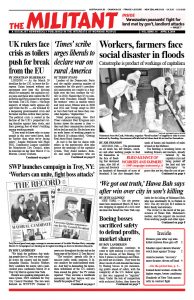In the midst of the capitalist economic “recovery” in the U.S. many workers are still living paycheck to paycheck and more working farmers are being driven deeper into debt or off the land altogether. This is exacerbated by social catastrophes like the far-reaching flooding in the Midwest.
The cost for inputs, such as seeds and pesticide, have gone up, but the prices farmers receive for their produce have fallen. Often, like on most small and middle-size dairy farms, they don’t even cover the cost of production.
In the 1980s, roughly 37 cents out of every dollar spent in the store on farm products went back to the farmer. Today, the figure is more like 15 cents. That means that more is being seized by monopoly capitalist processors, marketers and grocery chain bosses.
More land is concentrated in the hands of large capitalist farmers. Family farmers are caught in the squeeze.
While the number of farms has declined, farmers’ production has more than doubled, because of new machinery and mechanization, advances in animal and crop genetics, and widespread use of fertilizers and pesticides.
In 1935 there were 6.8 million farms in the U.S. By 2017 that number was down to 2.05 million. Farmers have been pushed to buy or rent more land and machinery to increase production to keep their heads above water.
As a result, farmers have to take out larger loans, which are harder to pay off, sinking deeper into debt. According to the U.S. Department of Agriculture, farm debt last year rose to more than $409 billion, the highest since the 1980s when the last big wave of farm foreclosures swept the Midwest.
Bankruptcies are at the highest level in 10 years. As family farmers struggle with overwhelming debt, the suicide rate in rural counties has risen steadily since 1999. Opioid and other addictions have also risen dramatically.
More than half of U.S. farm households today are losing money. The USDA estimates that median farm income was a negative $1,548 in 2018.
Dairy farmers have been especially hard hit. The number of dairy farms in the U.S. has dropped by more than 93 percent since 1970 — from more than 640,000 to some 40,000 today.
Seventy-one percent of U.S. poultry farmers live on or below the official poverty line. Prices paid to farmers for grain crops have also tumbled. A bushel of corn sold for more than $8 in 2012; now it sells for less than $4. Most family farmers have to work jobs off the farm to survive.
Farmers who are Black face special discrimination from government farm agencies and others because of the racism rooted in capitalism. A century ago African-American farmers owned more than 16 million acres — today it is 2.5 million.

